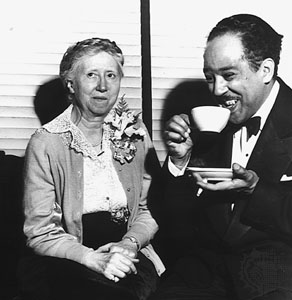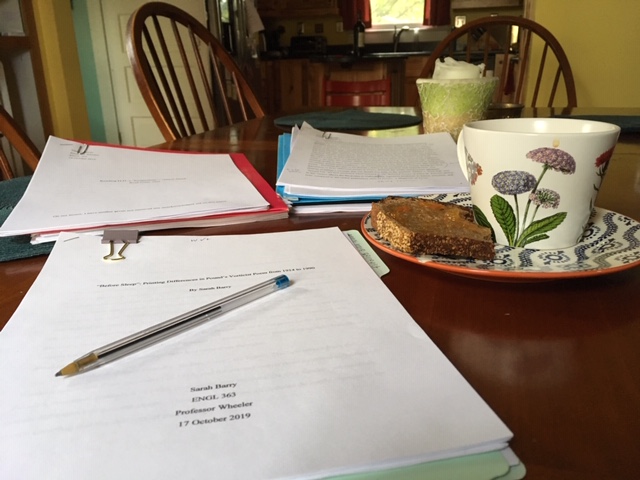
I started teaching modernism as a graduate student, leading discussion sections for Walt Litz at Princeton in ’91. When I arrived at W&L in ’94, I resolved to teach much more diverse syllabi: I put the version of modernism I’d studied in conversation with the New Negro Renaissance and included many women writers (Walt’s syllabus was all white and male). Soon I was bringing in formalist modernism, too–featuring the so-called “songbird poets” and analyzing various kinds of experiment that earlier discussions of the field hadn’t made much space for. Something I love about teaching, though, is that you can’t just rest on your laurels: I’m teaching you a version of modernism that’s fuller and more complicated than the one I received–aren’t I the greatest? Changes in scholarship and theory demand renovated approaches, but so do the students themselves.
I posted on Facebook recently that my students have never been so alert to questions of gendered and sexual violence in “The Waste Land” as they were this October. I was really glad I had this recent suite of short essays from Modernism/ modernity to bring to class, organized by Megan Quigley and centered on how #metoo has changed conversations about a modernist poetic monument. My current students think sexual violation, as reality and metaphor, is at the very foundation of modernism, and while I’ve always highlighted those elements in certain poems, I’m still trying to get my head around that as a perspective shift on the whole field. They’re very interested, too, in modernist portrayals of mental illness and how it’s persistently feminized; the more I consider those questions, the more foundational they seem, as well. Honestly, I wish I had more than twelve weeks with these students, so we could deepen our reading together.
We are, however, past midterms already! This weekend I’m reading their first essays, and the scholar to whom I owe the most for the success of this assignment is Suzanne Churchill at Davidson, a scholar of modernist little magazine culture and another Princeton survivor (it was a messed-up place back then). When W&L’s Digital Humanities cohort brought Suzanne here a few years ago, she visited a version of the class I’m now teaching; for the occasion, she loaned me a little magazine assignment she’d been using in her own courses. I’ve since modified it into a sequence of steps: we read Suzanne’s essay “Little Magazines” from Companion to Modernist Poetry; used class time to compare poems from our texts to their original presentations in little magazines; and read this excellent website on Georgia Douglas Johnson that Suzanne created with her students. Then we devoted a session to informal presentations of this response paper assignment:
“Go to the Modernist Journals Project site and either browse through the magazines or search for an author you’re interested in and follow the links (search last name, first name—it’s not case sensitive). Find an issue of a journal that interests you. It should be published between 1900 and 1945, and it should include at least one poem. Then post a brief reflection (~300 words) in which you identify and briefly describe the issue you chose and why you chose it, saying something about how a poem within it relates to other content and/or design elements. What kind of readership does the magazine seem to be projecting? How do font, layout, juxtaposition, and/or illustration affect the poem’s meaning?”
Finally, they wrote 8-page essays comparing poems in little magazines to other published versions, either building on that response paper or switching focus, if they preferred. I shouldn’t report on their discoveries here because this assignment resulted in some actual original scholarship–illuminating publishing circumstances that haven’t been discussed in print before, to my knowledge, although, of course, we’d all have to do a LOT of work to determine that for sure. This means that grading their essays has been slow (I have a lot of backtracking to do, as everyone wrote on different pieces/ publications) but genuinely exciting.
I had originally cancelled this coming Friday’s session, requiring them to go to at least part of a department retreat instead, but the scholar whom we had invited to visit cancelled. So, I asked these students, what would you prefer? Go to a different lecture or reading as class make-up, or reinstate that class and choose readings for it, anything you like? To my surprise, they wanted the class back, and they wanted to focus it on contemporary poems responding in some way to the modernists we’re studying. I’ve had a lot of fun assembling a reading packet! Not surprisingly, many of my own poems have been triggered by modernism, but I’m mostly steering clear of my own stuff in favor of Bishop on Moore; Wendy Cope and Jeremy Richards on Eliot; Evie Shockley on Anne Spencer; Honoree Fanonne Jeffers on Helene Johnson; William Woolfitt and Cynthia Hogue on H.D.; David Ray, Lauren K. Alleyne, and Hilde Weisert on Frost; Kenneth Koch on Williams; Terrance Hayes and Franny Choi on Hughes; and more (many of these great poems are not online). Thanks to Diane Kendig, Max Chapnick, and others for suggestions–please post more in the comments!
In short, in a busy season, this class is absorbing a lot of energy and creativity. I could use an extra weekend every week, one for the work and one for some downtime…but I’m also really happy that I can teach this class for so many years and still, well, make it new.

10 responses to “Teaching US Poetry from 1900-1950”
That reading packet sounds fantastic!
LikeLiked by 1 person
Thanks so much! I’m looking forward to seeing whether the students think so!
LikeLike
That sounds great. It’s wonderful that you are inspiring students to take hold of their own learning and dig into the text for themselves.
LikeLiked by 1 person
Found some more Moore-inspired poems! I forgot there were some by Jeredith Merrin and Joanie Mackowski in “A Right Good Salvo of Barks: Critics and Poets on Marianne Moore.”
LikeLike
This sounds amazing! I am happy to know contemporary students are thinking so deeply…especially about the past.
My own Moore-inspired poem (I’ve only successfully managed one) used one of her syllabic indented lines formats…I think I used her “Steamroller” tho my poem is about horses. It was great fun to work with–and not easy!
LikeLiked by 1 person
Yeah, I did the same with “The Fish,” following the rhyme scheme too–took a while!
LikeLiked by 1 person
Wow, as some above have said: sounds like a wonderful class (adjective inclusive to teacher, subject and students).
I’ve done my yearly dive into “The Waste Land” for three years now in order to perform it with music, and like your students I’ve been struck by several things that are overt themes in it that I don’t recall being discussed or having been “seen” when I first encountered it nearly 60 years ago, things like rape and gender fluidity. Some of this blindness may have been simple prudity or too many men straight and or closeted teaching, or some of it may be because later Eliot may have led folks in the post WWII world to read early Eliot in the light of the still living poet’s later outlook. From what I expected from that outlook and my loose understanding of later Eliot, I wouldn’t have expected him to write the poem as I find it now in the 21st century.
And yes, the sexual/gender politics of Modernism is an element overdue for examination!
Who are the “Songbird poets” by the way?
LikeLiked by 1 person
I was taught that Millay, Wylie, Teasdale, and others were collective known as the “Songbird poets”–very trivializing!! I’ve been meaning to add to this post, too, that I also directed my students to Jeannine Hall Gailey’s book Becoming the Villainness, and Paisley Rekdal’s book Nightingale (esp. the central essay), for feminist rewritings of the Philomel myth with lots of references to Eliot. The poets were publishing about these questions sooner and more powerfully than the critics, I think. And thanks for the good words, Frank–I really love this group!
LikeLiked by 1 person
[…] professor, and blogger I’ve referenced here earlier this year, Lesley Wheeler, recalls the term “The Songbird Poets,” which exclusive of it’s dismissiveness seems apt to me. The whole idea of poetry as song rather […]
LikeLiked by 1 person
[…] modernity; I have a piece in there about teaching Eliot recruited after the editor saw my blog post on that subject–an interesting development that has now happened to me a couple of times. And […]
LikeLike